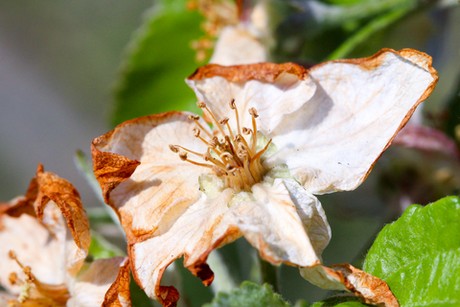“For growers, night frosts can often be very bad news. They’re difficult to predict, sometimes forcing the entire family out of their beds in the middle of the night in order to save the plants. Hopefully, sensors will soon be able to indicate automatically whether help is needed and, ideally, take the necessary action themselves”
Spring frosts are one of the main enemies of fruit cultivation in the Netherlands. Frosty weather in the spring can damage fruit blossom, ultimately reducing food production. In 2012 and 2017, much of the Dutch harvest was lost in this way. Despite this, there has been little research into the effectiveness of existing protective measures, such as sprayers, heat blowers and ventilators. Temperatures within an orchard can also vary widely, allowing chilly spring nights to cause needless devastation to large parts of the harvest.
Unique approach
This project, run in collaboration with farmers by the Geoscience & Remote Sensing department (part of the Faculty of Civil Engineering and Geosciences) is conducting research into local measures to combat spring frosts. The aim is to develop new knowledge that will help prevent crop losses as far as possible. Previous work has ignored the fact that temperature and plant physiological response vary strongly over a field. Fruit losses therefore exhibit similar variation and so effective mitigation measures should make use of local information. The approach is comprehensive: field experiments are being combined with state-of-the-art measurement tools, simulations and analysis of the effect of frost on trees and blossom. Here is just an example of what is being measured:
- what the water conditions are like in the soil;
- what heat and cold stress the plants are exposed to;
- whether there are any nutritional deficiencies.
One of the methods for keeping plants alive during frosts involves the use of small wind turbines. These move warm air from higher up to the ground lower down. Early studies using this technique have been promising.
Frost in the picture
This research project replaces the classic weather station with a completely independent network of sensors. It creates a real-time 3D image of the frost front, enabling growers to take effective measures immediately. It is essential that farmers themselves can quickly identify the vulnerable parts of a field so that they can take immediate action. Recent advances in sensor and wireless communication technology will make it possible to develop such diagnostic tool. In stage II, “Clarity on Fruit Frost” will deliver low- cost, low power, wireless, distributed sensor networks with automated data handling. This will enable real-time visualization of sub-zero regions, resulting in a decision support tool that will allow farmers to take immediate and precisely localized action.
Ultimately, these ventilators could activate automatically when the sensors detect that the plants are too cold, offering prospects of an improved harvest and a better night’s sleep for farmers.
To learn more about the project progress: Drones en windmolens om nachtvorst te bestrijden


